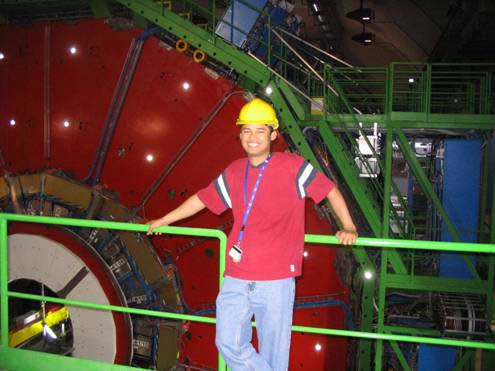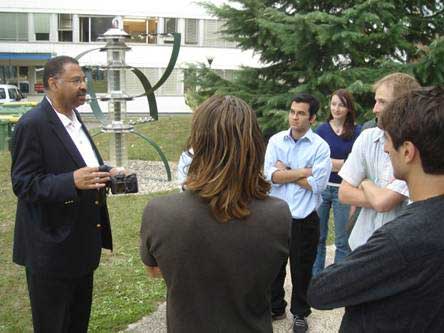Undergraduate Research at the LHC
Sarah Eno
When the Large Hadron Collider (LHC)1, a proton-proton collider located outside of Geneva, Switzerland, achieved a center-of-mass energy of 2.36 TeV on Dec. 13, 2009, it became the new energy frontier for accelerator-based studies of particles and their interactions. The previous holder of this title was the Tevatron, a proton-antiproton collider located outside of Chicago, Illinois, which began its operations in the early 1980’s. Since most of the students who are currently studying at our undergraduate institutions were born after the turn-on of the Tevatron, the LHC startup was their first opportunity to experience the excitement of crossing an energy frontier, with its potential for the direct discovery of new particles. Many undergraduates learned about the LHC, and the physics that will be studied there, from reports on the news, from departmental physics colloquium, and even from downloading "The LHC Rap"2. However, since the start of U.S. involvement in the LHC, undergraduate students at U.S. institutions have also been intimately involved in the work that made data taking with this new facility possible. They were involved in every aspect of the design and construction of the LHC detectors, the design of data-analysis strategies, and construction of suitable computing environments. In this article, I review various programs that allow U.S. undergraduates to become involved in this cutting edge research.
The most common way for undergraduate students to become involved in LHC research is through participation in one of the existing research programs at U.S. universities or national laboratories associated with the LHC’s four major detectors, ALICE3, ATLAS4, CMS5, and LHCb6. ATLAS and CMS are the two largest experiments. At the time of the writing of this article, 48 U.S. universities and national laboratories are members of the CMS collaboration, and 44 are members of ATLAS. Most of these institutions have at least one undergraduate student working with their group. Some universities, for example Cornell, the University of Kansas, M.I.T., the University of California at San Diego, CalTech, and the University of Florida have on order 10 students per year. Students often work on a project at their University during the academic year, and often go to CERN, the host laboratory of the LHC, during the summer. Students can work on a wide variety of projects. Students majoring in either computer science or in physics at the University of California, San Diego, for example, do essential work on the distribution of the vast amount of data produced at the CMS experiment to institutions in the United States. Students at other universities have worked on projects relating to, for example, calibration of temperature sensors, detecting excess muons from solar flares, calorimeter electronics construction and calibration, muon identification algorithms, electronics for silicon detectors, search strategies for fermiophobic Higges, search strategies for ADD Large Extra Dimensions, improving the sensitivity for SUSY searches using multi-variant techniques, and cosmic ray data analysis with ATLAS. Students at Cornell can enroll in a two-semester course on LHC research and then spend the summer at CERN. This course is also open to students from other universities, although most of the enrollment is local.
The National Science Foundation (NSF) also sponsors some larger, enhanced programs. Some give enhanced opportunities to undergraduates at their own institutions, while some allow students at any U.S. institution to participate in LHC research. An example is a joint program between Nebraska, Kansas, Kansas State, U. Illinois Chicago, and U. Puerto Rico Mayaguez, in the U.S., and the Paul Scherrer Institute and the Eidgenossische Technische Hochschule in Germany7. This program allows students at these institutions to learn the latest in the design of silicon-based detectors and to spend time abroad at a participating institution. A program at Boston University8 allows students to spend a semester at the University of Geneva with an emphasis on LHC physics. The largest and most well-known program is an REU program run by the University of Michigan9. This program has sent on order 15 students to CERN each summer, from a variety of undergraduate institutions, since 2001. It is sponsored by the NSF, the University of Michigan, and the Ford Motor Compnay. Unfortunately, none of these programs yet reach the achievement of the program sponsored by CERN for students from CERN member states.10 This program brings students to CERN for thirteen weeks in the summer. They spend half their time working with mentors, who are assigned to them, on an experimental project, and the other half attending lectures by world-renowned experts. It would be nice if American students could also have such an opportunity.
Many students who have participated in these programs have continued on to Ph.D. research in particle physics. They generally are satisfied with their experiences, which emphasize international collaboration, working in large groups, and cutting edge science. With the LHC experimental program now actively taking data, the opportunties for interesting research will continue, perhaps, as with the Tevatron, for the next 30 years.
Acknowledgements
I’d like to thank the following people for providing information for this article: Jim Alexander, Alice Bean, Ken Bloom, Sergei Chekanov, Hal Evans, Enricque Galvez, Yuri Gerstein, Al Goshaw, Nick Hadley, Vasken Hagopian, Gail Hanson, Arno Heister, Joe Izen, Lynne Kindle, Ashutosh Kotwal, Greg Landsberg, Pete Markowitz, Uriel Nauenberg, Steve Nahn, Homer Neal, Harvey Newman, Yasar Onel, James Proudfoot, Milind Purohit, Jim Rohlf, Reinhard Schwienhorst, Greg Snow, Dave Toback, Marguerite Tonjes, Frank Wuerthwein, Bolek Wyslouch, and Junjie Zhu. I also want to give my great thanks to Chandralekha Singh, who invited me to give a talk at the Gordon Research Conference, giving me the impetus to gather this information together.

Figure 1 Former University of California at Irvine undergraduate Milton Bose worked on the CMS detector (shown) under the tutelage of Professor Gail Hanson

Figure 2 Students involved in the University of Michigan REU program learn more about the LHC from Professor Homer Neal at CERN
2 http://www.youtube.com/watch?v=j50ZssEojtM
3 http://aliceinfo.cern.ch/Collaboration/
4 http://atlas.web.cern.ch/Atlas/Collaboration/
5 http://cms.web.cern.ch/cms/index.html
6 http://lhcb-public.web.cern.ch/lhcb-public/
7 http://physicsweb.phy.uic.edu/pire/index.html
8 http://www.bu.edu/abroad/programs/geneva-physics-program/
10 https://ert.cern.ch/browse_www/wd_pds?p_web_site_id=1&p_web_page_id=5836&p_no_apply=&p_show=N
Sarah Eno is a professor at the University of Maryland and a Fellow of the APS. Her research interests include searching for new particles and precision tests of the electroweak and strong forces using W and Z bosons.
Disclaimer- The articles and opinion pieces found in this issue of the APS Forum on Education Newsletter are not peer refereed and represent solely the views of the authors and not necessarily the views of the APS.
